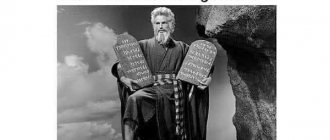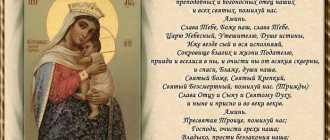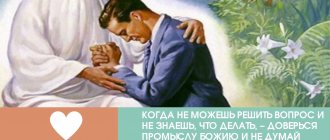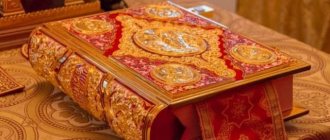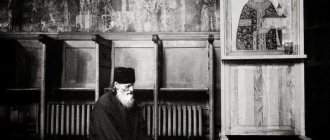Content:
“The Law of God” is the most popular textbook on the Orthodox faith for families and schools in the 20th century. The book clearly outlines the fundamentals of Orthodox Christian faith and life.
The book consists of five parts.
1. Basic concepts of the Orthodox faith.
2. Main prayers.
3. Retelling of the Old and New Testaments.
4. Creed, dogmas, commandments and sacraments.
5. Arrangement of the temple and worship.
Modern edition of the textbook. Moscow, Sretensky Monastery Publishing House, 2013
Children of first and second wave emigrants grew up separated from Orthodoxy
. In the early 50s of the 20th century, there was a need for a simple and accessible presentation of the foundations of the Orthodox faith and culture. Archpriest Seraphim Slobodskaya took on the task of compiling such a manual that is simple in presentation and at the same time comprehensive in its content.
“Sin, or evil, is a violation of the law of God; lawlessness, or in other words sin, is a violation of the will of God... All of us, people, come from Adam and Eve who sinned, and therefore we are born in a state of sin. Constantly passed on from generation to generation, sin took possession of all people and subjugated everyone. All people, some more, others less, are all sinners.”
“It is necessary to give one book containing all the fundamentals of Christian faith and life”
,” Father Seraphim wrote in the preface to the second edition of “The Law of God.” The second edition of “The Law of God” was published in 1967. Soon the book began to be published throughout the world.
All illustrations
Priest Seraphim did it himself to the “Law of God.”
The original idea
Father Seraphim was to create a multi-volume “Law of God,” but then the decision came to publish it in one volume, in the form in which it now exists.
“God created us, people, in His image and likeness - He gave us reason, free will and an immortal soul, so that, by knowing God and becoming like Him, we would become better and kinder, improve ourselves and inherit eternal blissful life with God . Therefore, the existence of man on earth has a deep meaning, a great purpose and a high purpose. There is and cannot be anything meaningless in God’s universe. And if a person lives without faith in God, not according to God’s commandments, not for a future eternal life, then the existence of such a person on earth becomes meaningless.”
"God's Law"
became a textbook for parish schools in America, was used as a guide in raising children in the family and as a self-instruction manual for adults who want to better understand the Orthodox faith.
"This is not just a textbook
The Law of God for children is a real encyclopedia of theological sciences for adults. This book should be on the table in every family after the Gospel,” said the famous theologian of the ROCOR, Archbishop Averky Taushev, at the funeral of Father Seraphim.
To the Soviet Union
“The Law of God” by Archpriest Seraphim Slobodsky came into being in the 1970s. The book was secretly copied and passed from hand to hand.
Handwritten prayers were also a common phenomenon in Soviet Russia.
In the early 1990s, The Law of God became the most popular book about the foundations of the Orthodox faith
in Russia. “The Law of God” was published in millions of copies. New editions of this book are still being published.
The law is the same for everyone
The church joke about how in one church the grandmothers brought a tray to set aside cookies does not seem so absurd if you pay attention, as at the Divine Liturgy (in almost any church) after the exclamation: “Catechumens, bow your heads to the Lord!” – a good half of the temple readily bows their heads. This suggests that either they were deep in thought (which is also not commendable) and bowed their heads automatically, or they do not understand at all what is happening at this moment in the service. But these are people, most of whom constantly go to church, receive the Sacraments, and read books. Our knowledge is fragmentary and not deep - we are people of superficial time, it seems to us that we are grasping everything on the fly, but in fact we are skimming the surface.
“Since Christian statehood was destroyed in the history of our Fatherland, teaching the population the basics of Orthodoxy has ceased,” says Father Job (Gumerov), and the consequences of this can be seen every time alien seeds easily take root where, it would seem , should not have taken root.
Many people do not know what and how they believe - this is the trend of our time. They sincerely do not understand how practicing yoga contradicts Orthodoxy, why it is a sin to work on Sundays, and they lose children who leave the Church: either simply into godless modern life, or into Islam, or sects - largely because they have not absorbed the unshakable the logic of Scripture and the spiritual beauty of church services.
That is why the voluminous work of Hieromonk Job and his sons should become a kind of family encyclopedia and one of the main books of the home Church - the family, especially since it reads like the most fascinating book.
The peculiarity of this book is some kind of cosmic perspective: as if you are looking through a telescope for the first time, and it turns out that space is not distant luminous points on the dark sky, but a precious, endless, sparkling depth, full of treasures.
And even what you seem to have known for a long time opens up with a hitherto hidden meaning, and what is still unknown beckons, like an adventure book in distant childhood.
Hieromonk Job (Gumerov)
– Father Job, for what purpose was the new book “The Law of God” written?
– Books on the Law of God, written before 1917, were textbooks in the most precise sense of the word. They contained: catechism, church prayers, sacred history, liturgical regulations. The authors of these books focused on the development of didactics and methodology. It was assumed that all students were believers and churchgoers. And therefore there is no apologetic orientation in these textbooks.
The book by Archpriest Seraphim Slobodsky, published in 1957, was written for the Russian diaspora. Although apparently numerous, it formed a small island in the Western world, stretching from America to Australia. The new generation, living among the heterodox, needed to preserve the traditions of Orthodox piety. Father Seraphim himself belonged to the second wave of emigration. He had teaching talents. As rector of the Church of the Intercession of the Blessed Virgin Mary, he created an exemplary parish school in Nyack (New York, USA). The book he wrote was intended as a manual for Orthodox families and schools.
We are in completely different historical conditions. Our society suffers from a serious illness of mass unbelief. With external freedom, but when there is nothing in the soul that would rise above vain and transitory needs, a person inevitably falls into an extreme degree of internal lack of freedom. His judgments, assessments, and interests are almost completely determined by the content of the media. However, the need for faith, inherent in the Creator, remains in man. It is one of the properties of the image of God in man. The soul of any person can be resurrected. An interest in the spiritual may awaken in her. While working on “The Law of God,” we wanted to create a book that could be read not only by a child, but also by an adult, a person with a modest education and a scientist. We strived to write clearly and accessiblely without simplifying the content.
While working on the book, we restrained ourselves from being edifying. The truth must convince itself. Aristotle also noted that “ truth and justice by their nature are stronger than their opposites” (Rhetoric. Book 1. Chapter 1). It is important to present the truth clearly and accurately.
The day-age theory greatly distorts the biblical teaching about the creation of the world. And if we take the day as an era, then how to determine evening and morning?
– Are there places in Father Seraphim Slobodsky’s textbook that have become outdated after 70 years?
– In this textbook, in the section devoted to the biblical account of the creation of the world, six days are understood as six long eras. This is a concession to evolutionism. The “day-age” theory was put forward in 1823 by the Anglican priest George Stanley Faber (1773–1854). This opinion has absolutely no basis. In Hebrew, the word olam is used to express an indefinite period of time or era. The word yom in Hebrew always means day , but never a period of time. Rejecting a literal understanding of the day greatly distorts the biblical teaching about the creation of the world. If we take the day as an era, then how to determine evening and morning? How to apply the blessing of the seventh day and the rest in it to the era? After all, the Lord commanded rest on the seventh day of the week - Saturday, because He Himself rested on the seventh day: “God blessed the seventh day and sanctified it, for on it He rested from all His works” (Gen. 2:3).
Archpriest Seraphim Slobodskoy
Further: the Lord created plants on the third day, and the sun, moon and other luminaries on the fourth. If we accept the idea of \u200b\u200b"day - era", it turns out that plants grew without sunlight for an entire era.
Father Seraphim cites as an argument a verse from the psalm: “For in Your sight a thousand years are like yesterday” (Ps. 89:5). But, according to the accepted interpretation, this verse speaks of the eternity of God, and not of the creation of the world, which took place in time (“In the beginning...”): “The Lord is eternal, before Him a thousand years are like yesterday, that is, without a trace, but therefore, an imperceptibly disappeared moment, like a “guard in the night” (night guard), divided into three parts (shifts), which for the sleeper go completely unnoticed. The years of human life are therefore insignificant before the eternity of God; human life can be compared to grass, which appears in the morning and dries up in the evening” (Explanatory Bible / Edited by Prof. A.P. Lopukhin).
The Holy Fathers understood the day of the first chapter of the book of Genesis literally.
Saint Irenaeus of Lyons: “Restoring this day in Himself, the Lord came to suffer on the day before Saturday - that is, on the sixth day of creation, on which man was created, through His suffering giving him a new creation, that is, (liberation) from death.”
Saint Ephrem the Syrian: “No one should think that the six-day creation is an allegory”
Saint Ephraim the Syrian: “No one should think that the six-day creation is an allegory.”
Saint Basil the Great: “And there was evening, and there was morning, the day is one... it determines the measure of day and night and combines into one daily time, because 24 hours fill the continuation of one day, if by day we mean night.”
St. John of Damascus: “From the beginning of one day to the beginning of another day is one day, for the Scripture says: and there was evening, and there was morning: one day.”
How then did the alternation of day and night occur before the creation of the luminaries, which appear on the fourth day? St. Basil the Great explains: “Then, not by the movement of the sun, but by the fact that this primeval light, to a degree determined by God, either spread out, then contracted again, day occurred and night followed” (Six Day Conversation 2).
In the section “On Faith and Christian Life” of Father Seraphim’s book about Charles Darwin, we read: “Even Darwin, whose teaching was later used by semi-scientists to refute faith in God, was a very religious person all his life and for many years was a church warden in your arrival. He never thought that his teaching could contradict faith in God. After Darwin outlined his doctrine of the evolutionary development of the living world, he was asked: where is the beginning of the chain of development of the animal world, where is its first link? Darwin replied: “It is chained to the Throne of the Most High.”
This statement contradicts what is known from primary sources. C. Darwin himself speaks about the loss of his faith: “So little by little disbelief crept into my soul, and in the end I became a complete unbeliever . But this happened so slowly that I did not feel any grief and have never since even for a single second doubted the correctness of my conclusion. And indeed, I am hardly able to understand how anyone could want the Christian teaching to be true” (Memoirs of the Development of My Mind and Character. Part IV. Religious Views). In 1871, Charles Darwin published the book “The Descent of Man,” in which he wrote: “Thus, we come to the conclusion that man is a descendant of a hairy, tailed, four-legged creature , apparently living in trees and certainly an inhabitant of the Old World.”
An error in assessing Darwin's views could arise due to the fact that Archpriest Seraphim used different sources when compiling the book. In 1966, in the “Preface to the second edition,” he wrote at the end: “When compiling this book, we used the following works: 1) “The First Book of the Law of God,” compiled by a group of Moscow teachers of the law and republished under the editorship of Archpriest. Kolcheva... 23) “Lessons and examples of the Christian faith” prot. Grigory Dyachenko and others. Some sources are indicated in the text of the textbook itself.” At the end of the section “On Faith and Christian Life,” which talks about Darwin, it is stated: “Compiled according to the book. Frank's Religion and Science, Is There a God? prot. G. Shorets and others.”
Hieromonk Job (Gumerov), priest Pavel Gumerov, priest Alexander Gumerov.
God's Law. - M.: Sretensky Monastery Publishing House, 2014. - 584 p.: ill. – A person goes to church, maybe even often, confesses, takes communion, listens to sermons and even reads something.
And he lives with the feeling that he knows everything. Does he need the book “The Law of God”? – Since Christian statehood was destroyed in the history of our Fatherland, teaching the population the basics of Orthodoxy has ceased. How significant this subject was can be judged by the fact that some outstanding pastors of the Church, despite their enormous busyness, taught in gymnasiums. Since 1857, the Holy Righteous John of Kronstadt was a teacher of the law at the Kronstadt City School, and from 1862, over the next 25 years, he taught the Law of God at the local classical gymnasium. Hieromartyr Thaddeus (Uspensky), being a teacher at the Ufa Theological Seminary, compiled a special teaching manual “Notes on Didactics,” which included a section “On teaching the Law of God.” He wrote: “The law of God is the main subject in school and the focus of all school instruction.” The holy righteous Alexy Mechev was a teacher of the law at the girls’ gymnasium E.V. for 13 years. Winkler. Other examples can be given.
Nowadays many Orthodox books are published. Many believers regularly read spiritual books. The range of reading varies. Some people like to read the lives of saints, books about elders. Others are fascinated by books on asceticism. From the vast patristic heritage, everyone finds something that is especially close to them. Someone studies books of liturgical content in detail. And although a lot has been read, the knowledge of the vast majority of believers remains fragmentary. In some areas of spiritual and theological knowledge they have significant gaps.
It is important to reveal the spiritual and educational meaning of the events of biblical history
We sought to make our manual systematic and universal. The book has a large section devoted to the Holy Scriptures of the Old Testament (168 pages). The Old Testament is our spiritual childhood. “If you are Christ’s,” says the holy Apostle Paul, “then you are Abraham’s seed and heirs according to the promise” (Gal. 3:29). Therefore, in our book we do not simply retell the main events of biblical history, but strive to reveal their spiritual and educational meaning.
Let me give you an example. After the people’s murmur against Moses and Aaron, the Lord, in order to strengthen the people’s faith in the high priest’s chosenness by God, performed a miracle with Aaron’s dry rod . He commanded Moses to take rods from all the leaders of the tribes and write the name of each on his rod. Moses placed them in the tent of meeting before the ark of the covenant. The next day Moses entered the tabernacle. Aaron's rod "sprouted buds, produced blossoms, and brought forth almonds" (Num. 17:8). It was laid before the ark of the testimony to be kept as a sign for the disobedient. The prosperous (in Slavic - vegetated) rod of Aaron was a symbol:
- the seedless birth of Jesus Christ according to the flesh from the Virgin Mary;
- the incorruptible flesh of the God-man;
- the abundance of the reviving and strengthening grace of God in the Church of Christ.
– In the parable of the publican and the Pharisee, the latter takes credit for two fasting days a week. On what days did the Pharisee fast? What does your textbook say: Did people fast in biblical times?
– The Pharisee in the Lord’s parable fasted twice a week voluntarily, which he took credit for. It was the custom of the Pharisees to fast on the fifth day of the week, when the prophet Moses ascended Mount Sinai, and on the second day, when he descended from the mountain.
According to the Law of Moses, only one day of fasting per year was established for all Jews - on the day of Atonement. During the Babylonian captivity, another one-day fast was established for the Jews: on the ninth day of the fourth month - as a sign of sorrow (in 587/6 BC the Chaldeans took Jerusalem), as well as on the tenth day of the fifth month, on which the city was destroyed and the Temple was burned.
However, any of the sons of Israel could voluntarily impose a fast on themselves. Such fasts are often spoken of in the books of the Old Testament. The fast could be one day, and sometimes lasted many days: the prophet Moses on Mount Sinai, in the presence of God, spent 40 days without food and water. The prophet Elijah fasted for the same number of days.
– And in your book we read: “Fasting among the Jews implied complete abstinence from food.”
– In biblical times and in the early Christian period there was no concept of “lenten food,” which sometimes does not differ in taste and calorie content from fast food. A fasting person completely refused to eat, put on sackcloth, stopped daily ablutions, and sprinkled ashes on his head. David did not eat anything for seven days (see: 2 Samuel 12: 16–21).
Jews voluntarily resorted to fasting: 1) before decisive events, the outcome of which depended on God's mercy; 2) during sincere repentance and humility before God and 3) to achieve full communication with God.
– Those who come to faith when reading the Old Testament may be confused by the abundance of sacrifices. It is known that from the Temple courtyard, where the altar was located, the blood of animals flowed into the Kidron stream.
– The All-Perfect God does not need anything. The people themselves needed sacrifices. The Lord gave the sons of the chosen people the opportunity to express in this way their devotion to God, love for Him and worship. But the most important thing is the educational significance of the Old Testament sacrifices: every day, from year to year, from century to century, they prepared people to accept the greatest Redemptive Sacrifice that Jesus Christ made on Calvary for the salvation of people.
Priest Alexander Gumerov, Hieromonk Job (Gumerov), Priest Pavel Gumerov. Photo: website of priest Pavel Gumerov
– Your book ends with a special section “The Spiritual World”, most of which is devoted to famous Christian miracles. How effective are stories about them in missionary practice? Have these testimonies helped you in your many years of pastoral work?
- The apostolic sermon was based precisely on the fact that it announced to people about the greatest miracle - the Resurrection of Jesus Christ. St. John Chrysostom says that the book of the Acts of the Apostles contains “precisely evidence of the resurrection , since it was easy for one who believed in the latter to accept everything else.”
As different as people are in the structure of their souls, in their mentality, in their upbringing, and in their life experiences, their paths to true faith are so diverse. Some have a morally sensitive soul. When such a person becomes acquainted with Christianity, learns about the Christian teaching about love, he turns to the Orthodox faith and finds what he has been looking for for a long time.
Rationalism and skepticism are often an obstacle to faith. If an event occurs in a person’s life that will prove the existence of another reality that does not fit into his consciousness, the shell of materialism and unbelief may burst, and he will eventually come to spiritual life. Evidence of miracles can help with this.
We talk in detail about those impressive miracles that are included in the treasury of Orthodoxy: the descent of the Holy Fire, the cloud on Mount Tabor, myrrh-streaming icons and holy relics. In the chapter devoted to the Shroud of Turin, we talk about the last large-scale study of this shrine, which lasted five years and ended in 2011. Scientists from the Italian National Agency for New Technologies, Energy and Sustainable Economic Development, led by Paolo di Lazzaro, have strongly refuted the claim that the Shroud of Turin is a medieval forgery: “A double image, frontal and rear, of a man being tortured and crucifixion, which is visible on the linen fabric The Shroud of Turin has numerous unusual characteristics, chemical and physical, that are currently impossible to reproduce in laboratory conditions ." Researchers have established an important fact: there is no image under drops of blood. This only means that the blood appeared before the drawing. The most important fact is that the Shroud testifies not only to the crucifixion of the Savior, but also to His resurrection . This great miracle puts a limit to the capabilities of science: it cannot penetrate the mystery, but it can indirectly confirm the Gospel.
Author-compiler:
Archpriest Seraphim Slobodskoy
(1912–1971) - clergyman of the Russian Orthodox Church Abroad, rector of the Intercession Church in Nyack near New York, icon painter, famous Orthodox theologian.
7 facts about Archpriest Seraphim Slobodsky
1. Seraphim Slobodskoy was born in 1912 near Penza into the family of a priest. The boy was named in honor of St. Seraphim of Sarov.
2. Seraphim’s father was repressed in the late 1930s. After graduating from school, Seraphim moved to Moscow, received an art education, and worked in his specialty.
3. Art education saved the captured soldier Seraphim in the German concentration camp “VI Fort”. One day he painted a portrait of a sentry, he was delighted, and from that day on the prisoner Slobodsky was settled in a separate house with the artist Semyon Podorozhny, who gave painting lessons to the camp commandant. On Sundays, Seraphim was even allowed to attend church.
4. Soldier Slobodskaya understood well that if he returned to his homeland, the Gulag would be waiting for him. He decided to stay in West Germany. In 1949, Seraphim Slobodskoy married the daughter of Prince Alexei Lopukhin, Elena. The marriage produced a daughter, Tatyana, and a son, Alexey.
5. In 1951, Seraphim took holy orders and after some time headed the community of the Intercession Parish in the city of Nyack, 45 km north of New York.
Church of the Intercession, Nyack. Photo by Steven Dolinsky
6. In 1957, the construction of the Intercession Church, led by Father Seraphim, was completed. The first edition of The Law of God was published that same year. Father wrote the book at night: during the day he supervised the construction, he himself painted frescoes on the walls of the temple and was involved in the youth camp of his parish.
Photo sergeylarin.livejournal.com
7. Father Seraphim died of sudden cardiac arrest after an evening service in 1971 and was buried in the Novo-Diveevo Convent in New York State.
Part 1 Preliminary Concepts
About the world
Everything we see: the sky, the sun, the moon, stars, clouds, the earth on which we live, the air we breathe - and everything on earth: grass, trees, mountains, rivers, seas, fish, birds, animals, animals and, finally, people, that is, ourselves - God created all this. The world is God's creation.
We see the world of God and understand how beautifully and wisely it is structured.
Here we are in the meadow. The blue sky with white clouds stretched high above us like a tent. And on the ground there is thick green grass dotted with flowers. Among the grass you can hear the chirping of various insects, and moths flutter over the flowers, bees and various midges fly. The whole earth here looks like a big beautiful carpet. But not a single carpet woven by human hands can compare with the beauty of God’s meadow.
Let's walk through the forest. There we will see many different types and structures of trees. There is a mighty oak, and a slender spruce, and a curly birch, and a fragrant linden, and a tall pine, and a thick hazel tree. There are also clearings with bushes and all kinds of herbs. The voices of birds, the buzzing and chirping of insects can be heard everywhere. Hundreds of different breeds of animals live in the forest. And how many berries, mushrooms and different flowers there are! This is your own big, forest world.
And here is the river. It smoothly carries its waters, glistening in the sun, among forests, fields and meadows. How nice it is to swim in it! It's hot all around, but the water is cool and light. And how many different fish, frogs, water beetles and other living creatures there are in it. It also has its own life - its own world.
And how majestic the sea is, having its own huge and rich underwater world of living creatures.
And how beautiful the mountains are, with their peaks, covered with eternal snow and ice, high above the clouds.
The earthly world is wonderful in its beauty, and everything in it is filled with life. It is impossible to count all the plants and animals that inhabit the earth, from the smallest, invisible to our eyes, to the largest. They live everywhere: on land, in water, in the air, in the soil, and even deep underground. And God gave all this life to the world.
The world of God is rich and diverse! But at the same time, in this huge diversity reigns a marvelous and harmonious order established by God, or, as is often called, “the laws of nature.” All plants and animals are distributed on the earth according to this order. And those who are supposed to eat what they eat, eat that. Everything has a definite and reasonable purpose. Everything in the world is born, grows, ages and dies - one thing is replaced by another. God gave everything its time, place and purpose.
Only man lives everywhere on earth and reigns over everything. God endowed him with reason and an immortal soul. He gave man a special, great purpose: to know God, to become like Him, that is, to become better and kinder, and to inherit eternal life.
In appearance, people are divided into white, black, yellow and red-skinned, but they all equally have a rational and immortal soul. Through this soul, people rise above the entire animal world and become like God.
Now let's look, in the deep dark night, from earth to sky. How many stars will we see dotted around it? There are countless of them! These are all separate worlds. Many of the stars are the same as our sun or moon, and there are also those that are many times larger than them, but are so far from the earth that they appear to us as small points of light. They all move harmoniously and in harmony along certain paths and laws around each other. And our earth in this heavenly space seems like a small bright point.
Great and vast is the world of God! It cannot be counted or measured, but only God himself, who created everything, knows the measure, weight and number of everything.
God created this entire world for the life and benefit of people - for each of us. God loves us so endlessly!
And if we love God and live according to His law, then much that is incomprehensible in the world will become understandable and clear to us. We will love the world of God and live with everyone in friendship, love and joy. Then this joy will never stop anywhere, and no one will take it away, because God Himself will be with us.
But in order to remember that we belong to God, to be closer to Him and to love Him, that is, to fulfill our purpose on earth and inherit eternal life, we need to know more about God, to know His holy will, that is, the Law of God.
